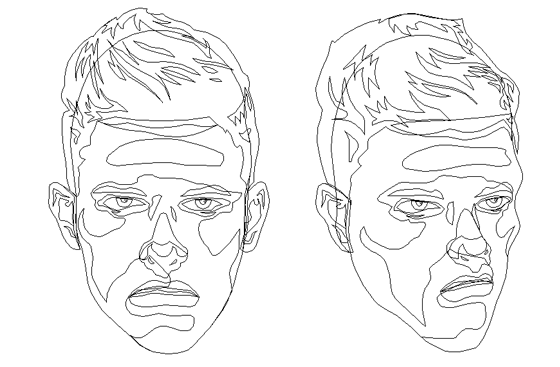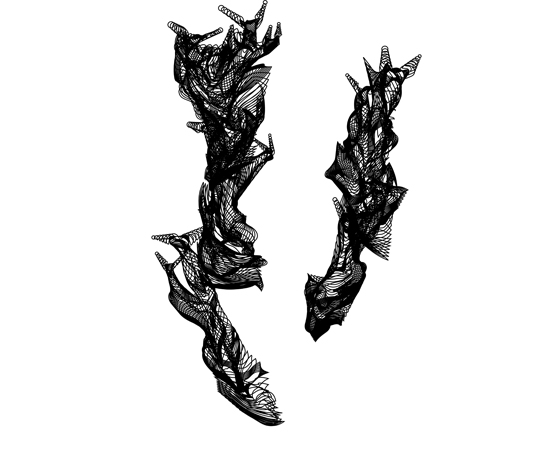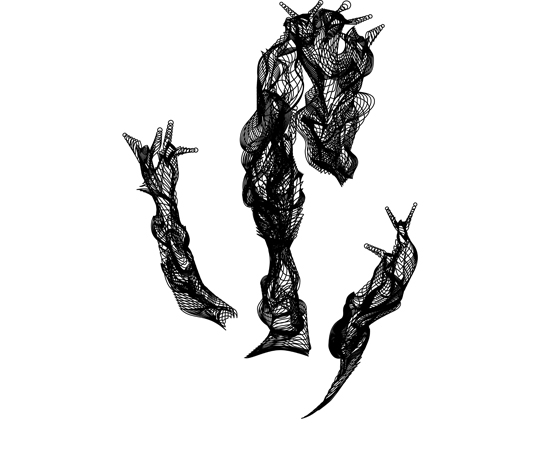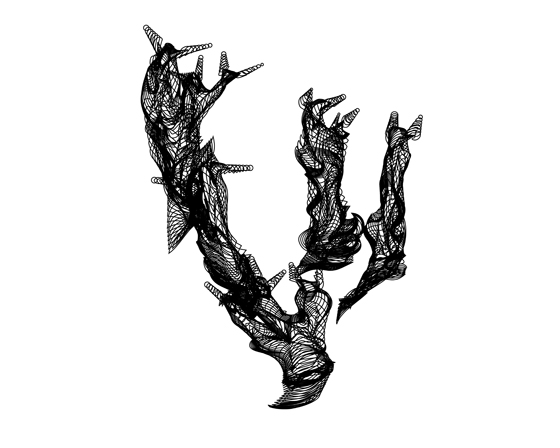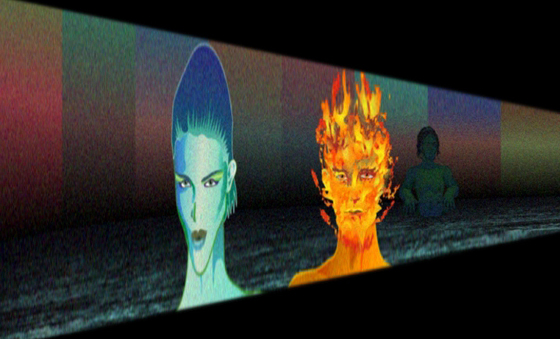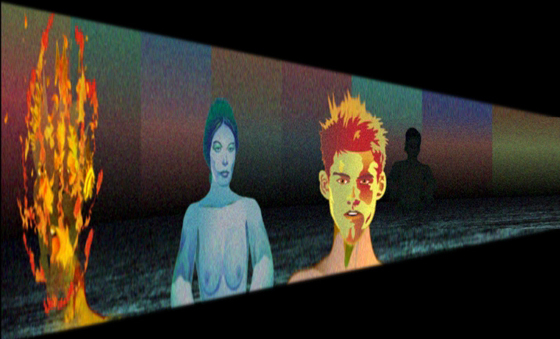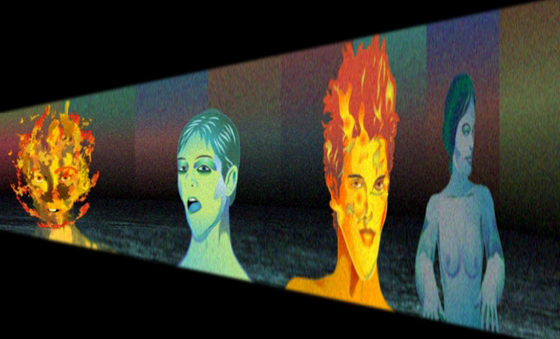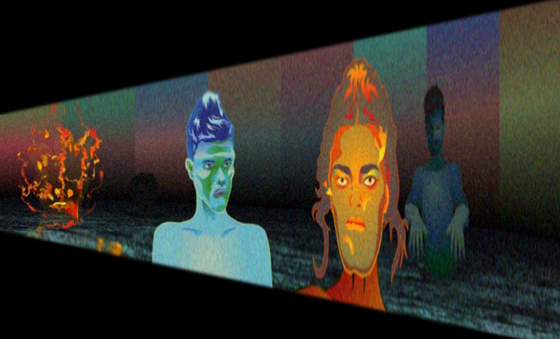Background
10 Flaming Youths is a 4-screen digital animation with quadraphonic sound. It is the second installment of a trilogy depicting youths in various states of dimensional transition. The work premieres by invitation in the Premier of Queensland's National New Media Art Award exhibition at the Gallery of Modern Art, Brisbane, 2010. The first work in the trilogy is 10 Transforming Youths - commissioned in 2009 by the Melbourne City Council's Public Art Program as the inaugural artwork to be projected from dusk to 3am at the new Signal building site (a Youth Arts facility on Northbank overlooking the Yarra River in the city centre of Melbourne).
10 Flaming Youths is rendered in a graphic hard-edged Pop style, 10 youths emerge one at a time from a gentle ocean sparkling in moonlight. The background night sky is a series of flat sombre colours, evoking a deep midnight realm. Naked from the waist up and bathed in a range of luminescent tourquoise tones, they stagger forward in a zombie-like stupor until framed in close-up. They move their heads side to side as if looking for something, but nothing in particular. Their stare is vacant; their posture peaceful. Nothing seems to be motivating them; they seem to sense nothing. Each youth pauses once framed in close-up. His/her head occupies the full height of one of the 4 screens. Staring straight ahead to the viewer, he/she slowly becomes enflamed. First, the face turns a heated ochre; the hair a burnt red. Then slight flames flicker up the face. More flames erupt, then a burst of fire engulfs the face as the hair contorts and twists. Yet during this the eyes and mouth remain fixed: there is no pain, no reaction. Within a few seconds, the face completely immolates, leaving a trail of shooting embers darting upwards to the night sky. No sooner has one youth disappeared into flames on one screen has another started to ignite on another. The pyrotechnical cycle continues, with each youth eventually re-emerging from the dark waters to become a human torch.
Credits
Concept & direction - Philip Brophy
Design, key animation & inbetweening - Philip Brophy
Source video filming - Philip Brophy
After Effects post-production & scripting - Steven Whatmough
Sound Design - Philip Brophy
Thanks - Russell Storer, Rebecca Manger
2010
NATIONAL NEW MEDIA ART AWARD - Gallery of Modern Art, Brisbane
Overview
While 10 Transforming Youths directly addresses 'youth culture' by way of working with (or rather, against) the dominating mediascape already saturated with youth imagery, 10 Flaming Youths extends the contemplative and reflexive aspects of youth imagery and youth states. Designed specifically for a gallery environment as opposed to an outdoor public projection, 10 Flaming Youths exploits the private reverie one can entertain in the museum environment.
The aim of the trilogy is to broaden the idea of transformation established in 10 Transforming Youths, and 10 Flaming Youths focuses on how one might imagine one's disappearance from the mortal plane. Youth - like fame, fortune and other grails of self-gratification - has long been depicted as something volatile, unstable and extinguishable like the flickering of a flame. Employing this well-worn mythology, the innocent youths in 10 Flaming Youths literally explode into flames. Evoking the idea of burning up too fast by living too fast, these self-immolating youths are vessels of overloaded desire. Their drive to live, to succeed, to overcome is both their invigorating fuel and their debilitating drug.
But these youths are accepting of their fate. Just as they scan the oceanic horizon with detachment, so too do they stare through us as they pass into another dimension. These are youths who may have limited experience, yet they no less bear the felt weight of an exhausted existence. The final flames are thus comforting: their faces evidence no pain, no anxiety, no regret. Though not visibly apparent, this tone of existence in youth is something gleaned in landmark films of youthful conviction and impassive reserve. The girls in Rosetta, The Child and The Page Turner whose hardened drive to survive masks all they feel. The boys who withhold any reaction to their apocalyptic surroundings in Kids, Gummo and Elephant. The children who stare plainly and quietly at dead bodies in Stand By Me and River's Edge.
Technical
Image
Hovering somewhere between airbrushed sterility, wall-stenciled sharpness and manga-styled appearance, the look of 10 Flaming Youths' faces employs Pop-effects to iconicise the individual portraits which comprise the animation. The faces of the 5 boys and 5 girls exude a calmly disquieting passivity. While the faces are distinct from each other - replete with racial suggestions in their visage and physiognomy - their pupils are completely identical in size. And despite the slickly stylized uniformity of their graphic appearance, each youth can be regarded as an individual character.
While 10 Transforming Youths presented varying ways in which each of the youths would age, 10 Flaming Youths presents this new set of youths as corporeal ghosts resilient to aging and death. They come from the sea, on an infinite loop.
Animation
10 Flaming Youths employs a technique of animation and compositing developed in works like Vox. Hand drawn images are converted into vector images (using Freehand) which are then animated (also using Freehand). The resulting look is highly-graphic, and the movement is deliberately unnatural. The meld of hard-edged 'super-flat' graphics with computer generated motion and morphing generates a conscious collapse between pseudo-realistic effect (the smoothness of movement generated by CG mathematically-correct motion simulation and depth) and the reality of the non-photographic 'pseudo-ness' (the 'superflatness' of the image that in no way attempts to convince the viewer that it is 'real').
To achieve and maintain this precise effect, the drafting and design of the youths' faces were configured in the 2 key states: one front-on, and the other in a 3/4-view. Careful vector alignment between these forms then enabled a highly detailed blending between those key frame, which in turn generates the final effect of doll-like head-turning. The torso and arms were handled in a similar way.
The animation of the flames is the result of a long series of tests to achieve a graphic non-realistic evocation of flames, in keeping with the surface look of the faces. The final outcome was achieved by individually animating each flame tongue, creating a discrete shape, trajectory and momentum for its flickering up the youth's face. As the flames increase in number and speed, the orb of the face undergoes a series of colours disfigurations, made from animating colour-changing shapes inset into the face's contours. Finally, matrix of individually tracked ember sparks (designed in Freehand and animated in Flash) are incorporated into the dynamics of the immolating face.
The final animation runs for 19 minutes, during which each youth appears and emerges from the 4 key positions of the widescreen panorama. The 'seascape' is actual ocean filmed and processed in Final Cut Pro to achieve a midnight lighting effect. All the final sequencing, compositing and layering of all elements was done in After Effects. The animation's dimensions across the 4 screens is a custom hyper-widescreen of 2,880 pixels wide by 576 pixels high.
Installation
Documentation from the installation at the Gallery of Modern Art, Brisbane, September 2010.
Sound Design
In contrast to the chori-like sensurround of voices intoning simple vowel sounds in 10 Transforming Youths, there is no scored music in 10 Flaming Youths. In place, a comparatively naturalistic sound design is configured, assembled from recordings of the ocean, fire, fireworks, plus some analogue synthesizer textures. The intention is to create a sound environment one might encounter at the precipice of the real world and what lies beyond its terrain.
Each event of immolation is keyed by layering of sound effects in a mono field (matched to whichever of the 4 screens is featuring the flaming event) with some light spatial spreading to the left and right. The seascape is comprised of 4 panning tracks of processed ocean waves (light lapping mostly, with an accent on the sound of foam as the wave gently approach). To this natural sonorum is added some heavier distorted textures, plus some high-pitched sliding glissandos of synthesizer tones (mixed in at a very low volume level). Both the heavy distortion and the high synth tones pan across the 4 speakers triggered by a set of LFO and random noise pulse generators.
The mix is in 4-channel in planar configuration, with 4 speakers are arrayed left to right to match the movement from left to right across all 4 projector screens.





